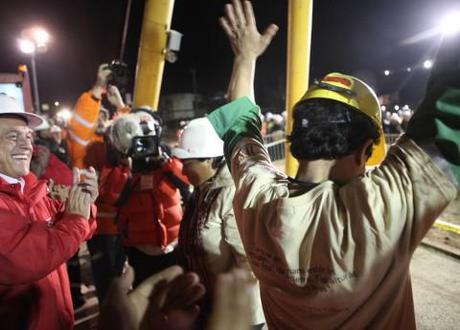
Rescue of the Chilean miners, August 2010. Photo credit: HUGO INFANTE/GOVERNMENT OF CHILE
Violent anti-government protests have broken out across Chile. The demonstrations come one year after the Chilean mine collapse and subsequent rescue mission that caught the world’s imagination. Reporting for Reuters, Alexis Krell wrote that demonstrators in Santiago had started fires in the capital, while 552 people were arrested in Valparaiso. Chilean President Sebastian Piñera has the approval of just 26% of Chileans, according to pollster CEP.
“Cacerolazo”, a form of popular protest in South America, was the top trending topic on Twitter, according to Reuters.
- “Cacerolazo”. According to Krell, demonstrators are “banging pots and pans in a ‘cacerolazo’, a popular form of protest in Latin America reminiscent of Chile’s 1973-1990 dictatorship.” The term took the global top spot in Twitter’s trending topics on Thursday night. The BBC reported that the violent protests are the culmination of weeks of student rallies; activists are demanding greater government funding for education and a revamp of the system. Riot police have fired tear gas and water cannon at the demonstrators, according to Sky News.
- Education. Even before the recent demonstrations, Aaron Nelsen argued in Time that the Chilean president had “lost his mojo” following a series of unpopular decisions that included the approval of a hydroelectric dam in Patagonia. Nelsen argued, however, that the most significant cause of dissatisfaction in Chile was education, stemming from policies introduced by Chilean dictator August Pinochet in the 1980s. The legacy of these policies is increased inequality: “U of Chile has had to pass on its increasing financial burden to its students. One result: Chilean families now finance 73% of higher education, compared to an average 16% for other members of the Paris-based club of developed nations, the Organization for Economic Cooperation and Development (OECD), to which Chile was recently admitted,” Nelsen wrote.
- “Lame duck”. Political scientist Patricio Navia told Reuters that Piñera’s unpopularity meant he risked becoming a “lame duck”, unable to push through legislation or policies. Writing in The New York Times, Alexei Barrionuevo argued that despite Chile’s apparent economic stability, resentment over financial inequality within Chilean society has been “building for years”. “Segments of society that had been seen as politically apathetic only a few years ago, particularly the youth, have taken an unusually confrontational stance toward the government and business elite, demanding wholesale changes in education, transportation and energy policy.”
After the rescue of the Chilean miners in August 2010, President Piñera’s approval rating was 63% (source: Time); a year on, his approval rating is 26%, according to the CEP.
- Chilean miners. President Piñera enjoyed a boost to his popularity following the rescue of the Chilean miners, with an approval rating of 63% at the time. “Los 33″, as they became known, were trapped underground for two months; the efforts to free them were broadcast around the world, and the eventual rescue led to international celebrations. But one year on, “most have been returned to poverty, and some are even worse off than before the disaster,” according to Jonathan Franklin in The Guardian. Franklin reported that the benefits of instant celebrity have been short-lived: “The men became superstars: they were cheered by 75,000 football fans at Wembley and invited on all-expenses-paid trips to Disneyland, Israel and Greece… but the money has long since run out.” However, Franklin also pointed out that the miners may yet receive financial stability, if they are successful in their lawsuits against the government, and once the revenue from book and film deals comes through. The decision to sue has been controversial: while some Chileans believe the cost of the rescue operation should preclude litigation, the miners argue that the government was to blame for the accident and the ensuring rescue costs. According to The Washington Post, many of the miners still suffer from psychological and physical problems stemming from the trauma.

